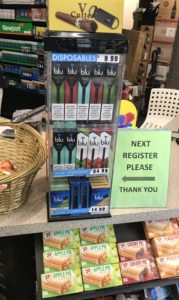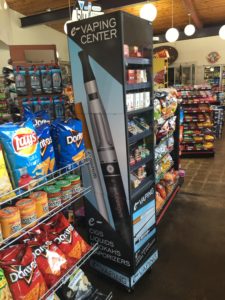Welcome to CounterTobacco.org’s “News and Research Roundup!” Each month we post a summary of the latest research, reports, and news stories on counteracting tobacco product sales and marketing at the point of sale (POS). Keeping up with what’s happening in the POS movement all across the country can help you choose policies and strategies that work best for your community. New research can help provide support for your work and evidence for the importance of the “War in the Store.” Have a story you don’t want us to miss? E-mail it to us!
New Research
Tobacco Retailer Density
- Neighborhood racial, ethnic, and income disparities in accessibility to multiple tobacco retailers: Mecklenburg County, North Carolina, 2015, Preventative Medicine Reports
- This study examined associations between residential “multi-retailer proximity”, defined as a residence’s accessibility to multiple tobacco retailers, and neighborhood level demographics, including race, ethnicity, and income in Mecklenburg County, North Carolina. Researchers found that residents of neighborhoods with the lowest proportion of White people were on average only 0.6 miles away from a tobacco retailer, while residents of neighborhoods with the largest proportion of White people were farther away from a tobacco retailer at an average of 1.11 miles. As well, neighborhoods with the highest proportion of Black residents, compared to neighborhoods with the lowest proportion of Black residents, were significantly closer to multiple tobacco retailers. The findings also suggest socioeconomic
 disparities exist such that residences in neighborhoods with the lowest income were closer to multiple retailers than residences in the highest income neighborhoods. Learn more about disparities in tobacco retailer density.
disparities exist such that residences in neighborhoods with the lowest income were closer to multiple retailers than residences in the highest income neighborhoods. Learn more about disparities in tobacco retailer density.
- This study examined associations between residential “multi-retailer proximity”, defined as a residence’s accessibility to multiple tobacco retailers, and neighborhood level demographics, including race, ethnicity, and income in Mecklenburg County, North Carolina. Researchers found that residents of neighborhoods with the lowest proportion of White people were on average only 0.6 miles away from a tobacco retailer, while residents of neighborhoods with the largest proportion of White people were farther away from a tobacco retailer at an average of 1.11 miles. As well, neighborhoods with the highest proportion of Black residents, compared to neighborhoods with the lowest proportion of Black residents, were significantly closer to multiple tobacco retailers. The findings also suggest socioeconomic
Tobacco 21
- E-cigarette and cigarette purchasing among young adults before and after implementation of California’s tobacco 21 policy, Tobacco Control
- This California study assessed the impact of a statewide Tobacco 21 (T21) law on access to tobacco products and purchasing behaviors of over 1,500 young adults aged 18-20. Prior to and after implementation of T21, the majority of respondents reported buying cigarettes from gas stations and e-cigarettes from vape shops; however, after implementation of T21, the proportion of respondents who reported purchasing cigarettes in the last 30 days at gas stations decreased. 54% of cigarette purchasers and 44% of e-cigarette purchasers reported it felt more difficult to purchase these products after implementation of T21; despite this, 65% of cigarette purchasers and 82% of e-cigarette purchasers reported that they were not refused purchase of these tobacco products in the past 30 days despite being underage. These findings suggest the need for improved enforcement strategies. Also of note, differences in the prevalence of cigarette and e-cigarette use before and after implementation of T21 were not statistically significant. Learn more about T21.
E-Cigarettes
- How are adolescents getting their vaping products? Findings from the International Tobacco Control (ITC) Youth Tobacco and Vaping Survey, Addictive Behaviors
- Data from over 12,000 respondents, ages 16-19, from the United States, Canada, and England was collected through the 2017 International Tobacco Control Youth Tobacco and Vaping Survey. Analysis found that approximately 7.5% of survey respondents reported purchasing a vaping product in the past year, with purchasing prevalence being significantly higher in US respondents than respondents from either Canada or England. Vape shops were the most common purchase location for survey respondents from all countries. Of those who reported vaping in the past 30 days, 42.5% reported
 obtaining their vaping products from a social source, while 41.4% reported obtaining their vaping products from a commercial source. Purchasing a vaping product within the past year was more frequently reported by males, those of legal purchasing age, and those who reported smoking and vaping more frequently over the past 30 days. Learn more about e-cigarettes at the POS.
obtaining their vaping products from a social source, while 41.4% reported obtaining their vaping products from a commercial source. Purchasing a vaping product within the past year was more frequently reported by males, those of legal purchasing age, and those who reported smoking and vaping more frequently over the past 30 days. Learn more about e-cigarettes at the POS.
- Data from over 12,000 respondents, ages 16-19, from the United States, Canada, and England was collected through the 2017 International Tobacco Control Youth Tobacco and Vaping Survey. Analysis found that approximately 7.5% of survey respondents reported purchasing a vaping product in the past year, with purchasing prevalence being significantly higher in US respondents than respondents from either Canada or England. Vape shops were the most common purchase location for survey respondents from all countries. Of those who reported vaping in the past 30 days, 42.5% reported
- Costs of vaping: Evidence from ITC Four Country Smoking and Vaping Survey, Tobacco Control
- Using data from the 2016 International Tobacco Control Four Country Vaping and Smoking Survey, this study assessed differences in prices between nicotine vaping products and combustible cigarettes in the United States, Canada, England, and Australia. In the US and Canada, both disposable vaping products and pre-filled cartridges were consistently more expensive than a comparable unit of cigarettes. In all four countries, e-liquids were consistently less expensive than a comparable unit of cigarettes; as well, in all countries, the start-up cost for a rechargeable vaping device was approximately 3-5 times more expensive than a pack of cigarettes. These findings suggest that the larger upfront costs of reusable vaping devices may deter cigarette smokers from switching to vaping; however, over the long-term, switching to vaping products is more economically attractive for consumers. Learn more about e-cigarettes at the POS and strategies for increasing tobacco products through non-tax approaches.
- Impact of e-cigarette use among a cohort of American Indian cigarette smokers: Associations with cigarette smoking cessation and cigarette consumption, Tobacco Control
- This observational pilot cohort study of American Indian/Alaskan Native adults assessed the association between e-cigarette use and both cigarette smoking reduction and cessation. After 18 months of follow-up, they found that e-cigarette use at baseline was not associated with either a reduction in the number of cigarettes smoked per day or with smoking cessation. Learn more about Native Americans and POS tobacco.
- E-cigarette advertising expenditures in the United States, 2014-2018, Tobacco Control
- While this study did not look at advertising at the point of sale, but rather via print, television, Internet, radio and outdoor (e.g. billboard) channels, a few interesting findings should be highlighted. In 2014, e-cigarette advertising expenditures totaled around $133 million; this number declined drastically by 2017 to $48 million but spiked significantly to $110 million in 2018. Between 2014 and 2018, Altria had the
 greatest expenditures in e-cigarette advertising, followed by Imperial Tobacco and Juul Labs. In 2019, Juul Labs’ advertising expenditures increased by an average of 1339% per quarter. Learn more about the war in the store.
greatest expenditures in e-cigarette advertising, followed by Imperial Tobacco and Juul Labs. In 2019, Juul Labs’ advertising expenditures increased by an average of 1339% per quarter. Learn more about the war in the store.
- While this study did not look at advertising at the point of sale, but rather via print, television, Internet, radio and outdoor (e.g. billboard) channels, a few interesting findings should be highlighted. In 2014, e-cigarette advertising expenditures totaled around $133 million; this number declined drastically by 2017 to $48 million but spiked significantly to $110 million in 2018. Between 2014 and 2018, Altria had the
- How and why California young adults are using different brands of pod-type electronic cigarettes in 2019: Implications for researchers and regulators, Journal of Adolescent Health
- A study of nearly 450 young adults from California, ages 17-24, found that over a quarter of respondents had ever used Juul and over half of these individuals had used a Juul device in the past 30 days. The majority of those who used pod-based devices like Juul stated they used pods because they are “easy to hide” (often called “stealth” vaping). Nearly half of pod users also stated that they did not know if they vaped varying brands of e-juices and pods, what the nicotine concentration was in their e-juice cartridges, or how long it took for them to finish a cartridge. This study suggests young adults may not be sufficiently aware of the contents of their pods and e-juices or their patterns of use. Learn more about e-cigarettes at the POS.
- News story: Young adults don’t know what’s in nicotine products they vape, Stanford Medicine
- Violation of US regulations regarding online marketing and sale of e-cigarettes: FDA warnings and retailer responses, Tobacco Control
- This study evaluated online retailers’ compliance to FDA-issued e-cigarette warning letters detailing retailer violations, the majority of which were sales or marketing of e-cigarettes to a minor. After 1 month, 64% of the websites who received a warning letter resolved the violation(s); however, 20% of online retailers, upon receiving the FDA warning letter, inactivated their website and 17% did not correct all violations outlined in the letter. Learn about the FDA Tobacco Control Act and POS.
- Is e-cigarette use in non-smoking young adults associated with later smoking? A systematic review and meta-analysis, Tobacco Control
- This meta-analysis of 17 studies concluded that young adults who used e-cigarettes but had never smoked combustible cigarettes had 4.59 times the odds of smoking cigarettes in the future, compared to those who never used e-cigarettes. The researchers do point out that self-reporting and a lack of controls were limitations in many of these studies. Learn more about e-cigarettes at the POS.
- News story: Are non-smoking young adults who use e-cigarettes more likely to smoke in the future?, EurekAlert!
- Electronic nicotine delivery systems marketing and initiation among youth and young adults, Pediatrics
- In this longitudinal study, researchers analyzed data from 2,288 youth, ages 12-17, and 2,423 young
 adults, ages 18-29, who had never used electronic nicotine delivery systems (ENDS) at baseline; their analysis aimed to determine the influence of ENDS marketing on ENDS use up to 2.5 years later. Youth who were able to recall exposure to ENDS marketing in the retail environment had 1.99 times the odds of initiating ENDS use up to 2.5 years later, compared to those who did not recall exposure to ENDS marketing at the point of sale. Similarly, young adults who were able to recall point-of-sale marketing of ENDS had 1.30 times the odds of initiating ENDS use up to 2.5 years later, compared to those who did not recall exposure to ENDS marketing at the point of sale. For young adults, recall of ENDS marketing on TV was also associated with higher odds of ENDS initiation. Learn more about restrictions on tobacco advertising and e-cigarettes at the POS.
adults, ages 18-29, who had never used electronic nicotine delivery systems (ENDS) at baseline; their analysis aimed to determine the influence of ENDS marketing on ENDS use up to 2.5 years later. Youth who were able to recall exposure to ENDS marketing in the retail environment had 1.99 times the odds of initiating ENDS use up to 2.5 years later, compared to those who did not recall exposure to ENDS marketing at the point of sale. Similarly, young adults who were able to recall point-of-sale marketing of ENDS had 1.30 times the odds of initiating ENDS use up to 2.5 years later, compared to those who did not recall exposure to ENDS marketing at the point of sale. For young adults, recall of ENDS marketing on TV was also associated with higher odds of ENDS initiation. Learn more about restrictions on tobacco advertising and e-cigarettes at the POS. - News story: Youth & e-cigarette initiation risk, Physician’s Weekly
- In this longitudinal study, researchers analyzed data from 2,288 youth, ages 12-17, and 2,423 young
Point of Sale Advertising and Marketing
- Tobacco point-of-sale influence on U.S. adult smokers, Journal of Health Care for the Poor and Underserved
- In this study, researchers used data from the Population Assessment of Tobacco and Health Study Wave 1 of nearly 13,500 current adult cigarette smokers to assess POS marketing disparities and their influence on tobacco purchasing behaviors. Smokers who purchased their cigarettes at convenience stores, gas stations, and tobacco stores were significantly more likely to report noticing tobacco ads or promotions at the POS; as well, they were significantly more likely to report buying a tobacco brand, other than their usual brand, as a result of POS promotions like special prices and store displays. Analysis also determined that non-Hispanic Blacks had 1.18 times the odds of noticing POS marketing, compared to non-Hispanic Whites. Additionally, individuals below the poverty level had 1.28 times the odds of noticing POS marketing, compared to those at or above twice the poverty level; in the same vein, smokers below the poverty level were significantly more likely to purchase a brand of tobacco product due to a promotion, a special price offer, or a store display. Learn more about restricting advertising and promotions of tobacco products.
- Youth daily exposure to tobacco outlets and cigarette smoking behaviors: Does exposure within activity space matter?, Addiction
- Data assessing the relationship between daily exposure to tobacco retailer outlets and young adults’
 cigarette smoking behaviors found inconclusive evidence of an association between participants’ cigarette smoking and tobacco retailer exposure; for this study, tobacco retailer exposure was operationalized as both the number of tobacco retailers within 100m of youth activity spaces and the number of minutes young adults spent within 100m of a tobacco outlet. Researchers did, however, determine that higher exposure to tobacco retailers was positively associated with the number of cigarettes smoked on that day. These findings suggest that day-to-day exposure may not be correlated with whether youth smoke on any given day, but that exposure is indeed correlated with the number of cigarettes youth smoke on any given day. Learn more about stores near schools and youth access.
cigarette smoking behaviors found inconclusive evidence of an association between participants’ cigarette smoking and tobacco retailer exposure; for this study, tobacco retailer exposure was operationalized as both the number of tobacco retailers within 100m of youth activity spaces and the number of minutes young adults spent within 100m of a tobacco outlet. Researchers did, however, determine that higher exposure to tobacco retailers was positively associated with the number of cigarettes smoked on that day. These findings suggest that day-to-day exposure may not be correlated with whether youth smoke on any given day, but that exposure is indeed correlated with the number of cigarettes youth smoke on any given day. Learn more about stores near schools and youth access. - News story: Youth exposure to tobacco outlets and cigarette smoking, EurekAlert!
- Data assessing the relationship between daily exposure to tobacco retailer outlets and young adults’
Other
- With socioeconomic status controlled, cigarette use is lower among American Indians/Alaska Natives than whites, Drug and Alcohol Dependence
- After controlling for socioeconomic status (income and education) and demographics (gender, age, and marital status), the researchers found that non-Hispanic whites had 1.23 times the odds of daily cigarette use, 1.47 times the odds of smoking 300+ cigarettes in the past month, and 1.57 times the odds of nicotine dependence, compared to American Indians/Alaska Natives. Learn more about Native Americans and POS tobacco.
- News story: Native Americans and higher cigarette use: Stereotype goes up in smoke, EurekAlert!
Industry News
- Philip Morris creates new job for its CFO to sharpen focus on rollout of new tobacco product, CNBC
- Juul Labs sought to court AGs as teen vaping surged, WSBTV
- Juul co-founder James Monsees steps down from board, company says, The Wall Street Journal
- Altria asks FDA to delay regulatory deadline due to coronavirus, Bloomberg Law
POS Policy in the Media
E-Cigarettes
- Idaho House moves to regulate vaping products like tobacco, Big Country News
- Bill aimed at curbing teen vaping dies in Utah Senate Committee, KUER.org

- Teens and parents: The Florida legislature passed vaping regulations. Here’s what to expect, Florida Phoenix
- Regulating vaping – policies, possibilities, and perils, The New England Journal of Medicine
Tobacco 21
- [MN] Hastings raises legal age to buy tobacco products to 21, RiverTowns.net
- Oklahoma House votes to raise minimum age for possession of tobacco products to 21, Tulsa World
- Iowa Senate passes a bill to raise minimum age to purchase tobacco, Daily Iowan
- Utah bill speeds up ban on smoking and vaping under age 21, The Salt Lake Tribune
- [WI] State Assembly votes to raise age to purchase tobacco products to 21, The Badger Herald
- Colorado House passes tobacco 21 measures, The Center Square
- [MN] Pequot Lakes: City is first in county to raise legal age to buy tobacco products to 21, Brainerd Dispatch
- Florida poised to raise smoking, vaping age to 21, AP News
- [KY] Beshear signs more than 35 bills including law to restrict tobacco, vaping, WBKO.com
Menthol and Other Flavored Tobacco Products
- [CA] Solana Beach City Council bans flavored tobacco sales, Del Mar Times
- S. House passes bill that dramatically tightens tobacco regulation; Trump administration signals its opposition, Winston-Salem Journal
- [CO] Regulation of flavored nicotine products moves forward in the House, 9News
- The effort to ban flavored vaping products, menthol cigarettes in Colorado now has a big asterisk, The Colorado Sun
- Fruit-flavored shisha more damaging to smokers’ health, research finds, The National [UAE]
- [Davis, CA] Council approves bans on flavored tobacco sales, open campfires on public property, Davis
 Enterprise
Enterprise - Raimonodo’s actions to end the sale of flavored e-cigarettes will protect Rhode Island kids; new poll shows two-thirds of voters support the move, Campaign for Tobacco-Free Kids
Tobacco Retailer Licensing
Health Warnings
Other
- FDA restrictions contribute to additional slumping of e-cigarette sales, Winston-Salem Journal
- Tax cut for ‘modified risk’ tobacco added to Georgia House vape bill, The Atlanta Journal-Constitution
- FDA warns retailers, manufacturers to remove unauthorized e-cigarette products from market, FDA.gov
- N.Y. physicians urge Gov. Cuomo to ban tobacco to battle coronavirus, NY Daily News
Find more stories in last month’s News and Research Roundup.
Know of a story that we missed? Email us, and we’ll be sure to include it in next month’s roundup!


